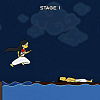The enduring charm of 'potchitro'

Understanding art is not only about appreciating the finer details—the aesthetics, the technique, the colour, and the characteristics of the genre—perhaps it is much simpler. And in reality, it is!
Every piece of art, great or otherwise, creates an impression on the human mind and only when an onlooker manages to engage in a tête-à-tête, the artwork unravels its countless layers of beauty. Shambhu Acharya and his scroll paintings (known as potchitro) achieve that effortlessly. We have long parted ways from our rustic ways and it is egocentric to presume that pastoral Bengal will not follow suit. For nine generations the Acharya family has depicted rural Bengal in a dream-like setting, where life was simpler but in no way easy.
Potchitro, in older times, were also an integral part of entertainment. A patua would paint a sequence of events from mythology, religious scriptures, or folktales in a series of rectangular frames in a vertical format. The performer (sometimes the artist himself) would then gradually unroll the scroll, pointing to different illustrations with a thin bamboo staff. Percussionists accompanied the rhymed metrical verses in front of an eager crowd, which gathered in the courtyard of rural homesteads.

With the passage of time, such acts lost their popularity and slowly the tradition faded in the annals of Bengal. And along with the performances, the paintings also vanished. It was only as recently as 1977 that renowned folklore specialist Tofail Ahmed stumbled upon a Gazir Pata, hitherto considered to be the last remaining piece of Gazir Pata, a unique style that once flourished among the folk artists of the eastern part of Bengal. Ahmed soon embarked on a quest to rediscover this lost form of art and his search brought him to Shudhir Acharya, a quaint artist residing in Bikrampur.
Shudhir was a patua who maintained his livelihood by making idols of Hindu deities. Recognising the talent of Shudhir Acharya, Tofail Ahmed encouraged him to devote time to potchitro. This re-kindled the flame in the artist's heart and after years of neglect, brought the this form of near-extinct folk art out in open.
But it would take Shambhu Acharya, the able son of Shudhir, to take it further—even across borders.

Shambhu Acharya takes pride in the fact that even before he learned the alphabets, he could draw and paint. Traditionally, potuas use natural ingredients to prepare the colours for scroll paintings. This was to Shambhu's advantage. As a child he made best uses of kochu (taro stems), pui shaak (Malabar spinach), powdered bricks and almost everything he could lay his hands on to create colour and paint! And this continues to this day.
For black, he makes use of soot; for shades of red, he experiments with vermillion conventionally used as sindoor; egg yolks, wood apples, sabu dana and various kinds of clay are all important ingredients in his art.
This is a laborious process involving days for making one single colour, but Shambhu feels that it is important for his expression. As far as preparing natural dyes is concerned, Shambhu Acharya can rightfully claim a unique position in the local art scene.
Shambhu's puritan position, however, is not limited to colours only. For preparing the canvases, he uses markin fabric and utilises age-old techniques. The cloth is fast layered with mud or cow dung and dried. It is then layered again with a paste made from tamarind seeds and powder of brick and chalk. The final canvas, called doli, is not only durable but adds yet another unique feature to Bangladeshi scroll painting.
For almost 450 years, the Acharya family has been nurturing the art of making potchitro, which depicts various mythical and religious themes, but it is possibly in Gazir Pata that Shambhu excels at.
Gazir Pata is a form of scroll painting that depicts the bravery and conquests of Ismail Gazi, a Muslim general who served the Sultan Barbak in the 15th century. Painted in panel form, the potchitro depict various miraculous events associated with Gazi Pir and his supernatural powers.

The Gazi seated on a tiger with its tail lifted; a cow being grabbed by a tiger; Daksin Ray, regarded as a king of tigers, holding a mallet in his hand—these are the spellbinding imageries that narrate the tale of the Gazi.
After successfully re-introducing potchitro in the mainstream, Shambhu Acharya had the privilege of exhibiting in London where he, along with his companion Durjon Ali Miah, recreated a scene from the distant past in a remote village of Bengal. As Miah narrated the saga of Gazi Pir, Shambhu highlighted the relevant images in the scrolls.
Always true to his beliefs, Shambhu, inspired by noted historian Professor Dr. Enamul Haque, attempted to depict the struggle for freedom of this nation, beginning with the Battle of Plassey to Mujib's assassination in 1975. Aptly called the Sahi Shaheed Mujibnama, through 20 scrolls and a poignant narrative written and composed by Professor Haque, he recreated an honest presentation of the two aspects of this heritage—the images and the songs.
An exhibition featuring 40 of Shambhu Acharya's latest works is now being held at the EMK Centre, Dhanmondi. The event will continue till July 27, 2017.
Shambhu Acharya's works have been included in the collection of the Victoria and Albert Museum London, and in numerous private collections at home and abroad.










Comments